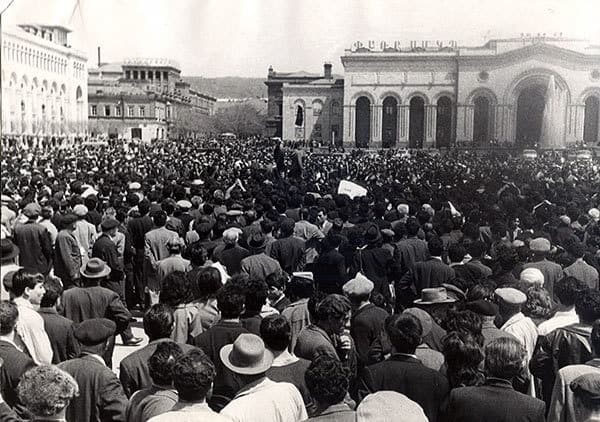THE FIRST COMMEMORATION OF THE GENOCIDE IN SOVIET ARMENIA (April 24, 1965)

On April 24, 1926, the mourning bells sounded at the Holy See of Echmiadzin for the last time. The Central Committee of the Communist Party of Armenia resolved that year that all commemorations of the Armenian Genocide, should end. This followed the signature of the Soviet-Turkish non-aggression pact of December 1925.
The period going from the 1920s to the 1950s would be one of oblivion, with the exception of some literary works. After the demands for the return of Kars and Ardahan in 1945-1947, the Soviet Union officially renounced any territorial claims from Turkey on behalf of Armenia and Georgia.
On the eve of the fiftieth anniversary, the echoes of the commemoration plans underway and the imperative for active revindication coming from the Diaspora, as well as the delayed effect of Nikita Khrushchev’s “thaw” in Armenia, would become the catalysts for a commemoration of the victims of 1915 at an official level in Yerevan. An important role was played by Yakov Zarobian (1911-1980), First Secretary of the Central Committee of the Armenian Communist Party.
In 1964, after several consultations with important historians and other intellectuals, Zarobian had various meetings with the highest echelons of the Soviet political elite and managed to obtain consent for the commemoration.
Besides books and articles, programs of radio and TV, and various public events, in February 1965 the Central Committee approved the project for the construction of a memorial to the genocide victims. The architectural competition was announced in March 1965.
In the morning of April 24, Lenin Square (nowadays Republic Square) was filled with thousands of young people, who surprised the authorities with an unauthorized demonstration. The exhortations of various intellectuals to disperse went unheeded, as well as an attempt by the police. Later, the demonstrators started marching through the main streets of downtown Yerevan, shouting patriotic slogans, like “Our lands, our lands,” and carrying banners that demanded the return of Armenian occupied lands. The peaceful march was not disturbed by the authorities, and the demonstrators were able to lay a wreath at the tomb of Gomidas Vartabed in the Pantheon of Yerevan. There are various estimations of the number of participants in the demonstrations, ranging from 20,000 to 100,000.
In the evening, a big group moved to the Yerevan Opera, where an official event by invitation was being held. Attempts to enter by force ended in incidents and police intervention. A few young people managed to enter the theater and disrupt the event, leading to its interruption.
On the same day, the celebration of the Divine Liturgy and a hokehankeesd in Holy Echmiadzin had been allowed by the authorities. A memorial to the genocide was inaugurated in October 1965 in the courtyard of the monastery.
Following the demonstrations of April 1965, the new Soviet government, led by Leonid Brezhnev since late 1964, carried out a purge of the highest ranks of the Communist Party of Armenia in February 1966. Zarobian was replaced along with several party leaders and given a new position in Moscow.
The wave of national rebirth that had started in the late 1950s had reached its peak on April 24, 1965, and this renaissance continued its reflections in the following years. The memorial of the genocide in Tsitsernakaberd was inaugurated in November 1967.
Previous entries in “This Week in Armenian History” are on the Prelacy’s web site (www.armenianprelacy.org).
